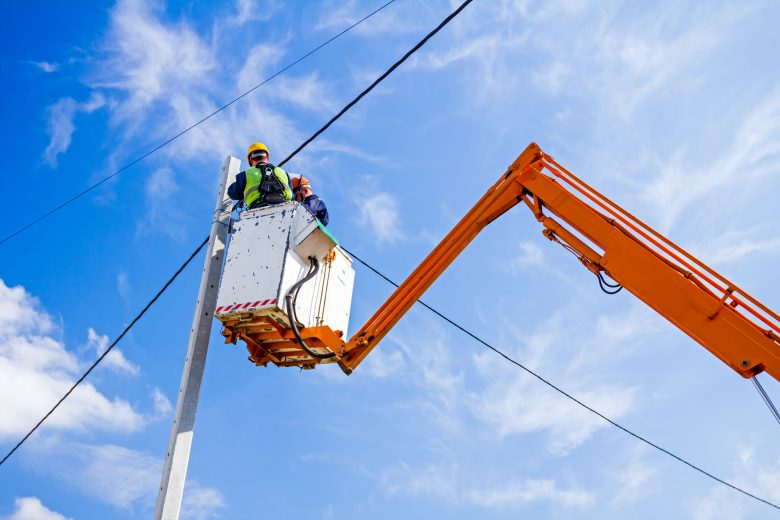Aerial lifts are used by various industries from construction to entertainment and can be divided into four categories: manually-propelled, self-propelled (e.g., scissor lift), boom-supported (e.g., with a telescopic or joined boom), and vehicle-mounted. Often, aerial lifts are operated by workers who are not trained properly, use old or faulty equipment, or don’t wear fall arrest systems.
Aerial lifts are an extremely useful tool for many workers, but they don’t come without pitfalls. In 2016, a number of accidents involving scissor lifts caused OSHA to issue a hazard alert concentrating on the employers’ obligations and preventive measures required for safe operations.
In fact, many people are involved in numerous fatal and non-fatal aerial-lift-related incidents each year. This is why it’s so important for anyone who uses them to be properly trained, provided with the right PPE, and follow the safety requirements set by the lift’s manufacturer and the company’s safety program.
Inspection
Every aerial lift has three components: a base/chassis, a lift mechanism (tower, boom, etc.), and a platform (bucket, basket, stand or cage). Each of these needs to be inspected before use to ensure proper working conditions. When performing the inspection, workers need to pay close attention to a number of factors, including checking the following:
- steering axle for damage or missing parts;
- battery cells for signs of damage, improper seals or broken insulation cables;
- hoses and their fittings for leaks;
- fluid levels (oil, hydraulic, fuel, coolant);
- wheels and axles for loose, damaged or missing parts, and the tires for cracks, bulges, cuts, proper inflation and air pressure (this is very important for keeping stability)
- chassis (including outriggers, stabilizers and guard rails);
- lower controls (the override controls);
- boom for flaking paint (this can be a sign of structural failure)
- platform for damage;
- gate and railings for damage or missing parts;
- harness systems;
- emergency foot pedal; and
- emergency release valves.
Once everything is confirmed to be in order, the employee should finish the inspection by starting the lift and ensuring that the controls work smoothly. It’s worth remembering that systems checks need to be performed outdoors with a fire extinguisher on hand.
It’s also worth noting that inspections breed complacency because most of the components rarely fail. Even if workers start out with the best intentions to do an inspection before use, they can quickly come to believe that an inspection can be skipped now and then because everything checks out most of the time. Over time, this can lead to fewer and fewer inspections—until something fails unexpectedly.
To keep this from happening, you have to give people other reasons for doing safety inspections. You can make it mandatory to fill out an inspection form and have consequences if it isn’t, but workers can still check things off the list without carefully inspecting each area. A much better way to motivate thorough inspections is to make people aware of how complacency can erode their commitment to inspections over time and explain why they need to build a solid habit of checking thoroughly during each inspection. Not only will this lead to stronger inspection habits, but workers may also become more aware of other types of complacency and additional factors that might influence the safe operation of the lift such as rushing, frustration or fatigue.
Stability
It’s imperative to keep the center of gravity as low and as centered as possible when operating the aerial lift because one fast turn or one pothole can cause the entire machine to tip over.
- Aerial lifts should only be used on level, firm ground.
- Wind speeds should be considered when operating the platforms (it’s not unheard of for scissor lifts, for example, to be blown over while in operation).
- The weight on the platform should never exceed the manufacturer’s load rating.
- Check the work area for bumps, potholes and debris before moving in lifts.
Safe practices
Aerial lifts should be operated by trained staff in accordance with the written instructions of the manufacturer and/or the safety plan of the workplace. There is a number of safe practices that also need to be remembered.
- Safety components must never be removed or modified.
- The operator needs to focus on safe operations and concentration is imperative. It should be made clear that no phones, headsets or other distractions are allowed.
- It’s important to take the least obstructed and most level path when driving to the work spot.
- Don’t travel on a slope that exceeds specifications for the lift.
- Don’t use objects to steady the platform.
- Position the lift as close to the work area as possible.
- When parked on an incline remember to use wheel chocks.
- Clearly mark off where the lift will be operating: use cones, signs and other work zone warnings.
- Climb onto the platform through the proper access means and ensure the gates are secure.
- Never climb on the boom or scissor arms.
- Don’t stand on boxes, ladders, railings, etc. and make sure the platform is clear of obstructions, debris, ropes and hoses.
- Use proper fall arrest systems and always wear them on the platform.
- Add clearance for movement and swinging power lines (always be aware of overhead obstructions and electrical wires). Electricity can arc through the air so assume electrical parts are energized unless you know for sure that they are not.
- Be aware of coworkers, other equipment and obstructions when operating the lift.
- Stow power tools when not using them and never leave them hanging by their cords.
Lifts come with manufacturer’s instructions for a reason. Just like with ladders, many people assume that once they understand how to use a tool they can ignore the safety rules. But it’s imperative that workers follow the best practices outlined above and receive refresher training that regularly stresses the importance of safety rules.

